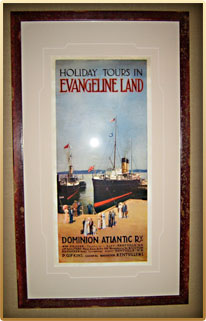
Train Station › Now, a little railroad history
 The Dominion Atlantic Railway (DAR) was formed by merger in 1894, and brought reliable railway service between Halifax and Yarmouth, vital to the economy of the Annapolis Valley.
The Dominion Atlantic Railway (DAR) was formed by merger in 1894, and brought reliable railway service between Halifax and Yarmouth, vital to the economy of the Annapolis Valley.
A critical component of the DAR’s early passenger and freight business was its connections with various ferries that operated in the Bay of Fundy and the Gulf of Maine. By 1904, the DAR owned and operated twelve steamships and ran services between Yarmouth-Boston, Yarmouth-New York and Digby-Saint John.
These ferry services launched the DAR into the forefront of Nova Scotia’s budding tourism industry, bringing travelers from the United States and Upper Canada into the unspoiled Nova Scotia countryside…and into historic Annapolis Royal, already 300 years old.
But in 1912, the Town’s wooden passenger station burned to the ground… a blow to both tourism and commerce. Mr. Gifkins, the general manager of the DAR, agreed to build a new station (he had worked in Annapolis Royal early in his railway career) and his remarks were reported in the local newspaper.
From the Annapolis Spectator, June 12, 1913:
The new station is an assured fact. As a result of Mr. Gifkins’ visit, the much needed new railway station will be located on the land back of the Rice property, now occupied by Joe Edwards. Victoria Street will be extended to make the proper approach.
Mr. Gifkins kept his promise, and in only nine months, Annapolis Royal had a “fancy” train station, designed in the Arts and Crafts style by the company’s chief railway architect in Montreal.
Unlike other DAR stations, usually constructed of wood, it was built of brick with a slate roof.
From the Annapolis Spectator, March 12, 1914:
The new railroad station was opened on Monday. A large crowd of citizens was on hand to see the first train come in.
Why build a “fancy” station in Annapolis Royal? It was to impress and encourage the tourists getting off those DAR trains and ferries — coming to visit old Fort Anne, or stay the summer at Milford House or fish and canoe at Kejimkujik. The new station was, in other words, part of the DAR’s marketing plan, and it was built to be beautiful.
Its beauty lasted only as long as its usefulness. After the final VIA Rail train went by in 1990, the station was used sporadically, but by early 2002, when I first considered the restoration project, it had long been boarded up, flooded to the floor joists and left to rot.